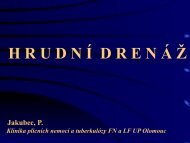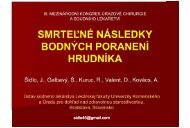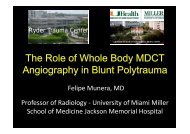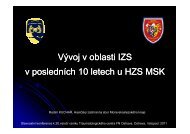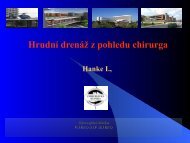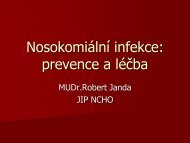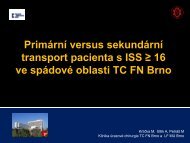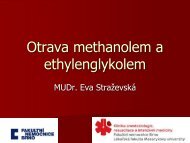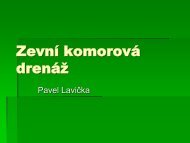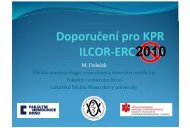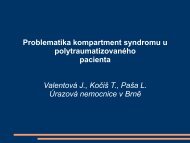Professor Narinder Rawal, MD, PhD, FRCA (Hon) - AKUTNE.CZ
Professor Narinder Rawal, MD, PhD, FRCA (Hon) - AKUTNE.CZ
Professor Narinder Rawal, MD, PhD, FRCA (Hon) - AKUTNE.CZ
- No tags were found...
You also want an ePaper? Increase the reach of your titles
YUMPU automatically turns print PDFs into web optimized ePapers that Google loves.
<strong>Professor</strong> <strong>Narinder</strong> <strong>Rawal</strong>, <strong>MD</strong>, <strong>PhD</strong>, <strong>FRCA</strong> (<strong>Hon</strong>)Department of Clinical MedicineDivision of Anaesthesiology and Intensive CareUniversity HospitalÖrebro, Sweden
Persistent postsurgical pain Mechanism – pathophysiology Prevalence Risk factors Role of surgical technique Issue of unnecessary surgery Can persistent postsurgical pain be prevented?The role of analgesic techniques
1. Local and systemic chemicals drivepain signalling2. Neuroma at injury site - excitabilityin sensory fibres3. Changes in gene expression indorsal front ganglion4. Dorsal horn - central sensitization5. Descending controls modulatetransmission in spinal cord6. Limbic system and hypothalamus -altered mood, behaviour7. Sensation of pain generated incortex (past experiences, culturalinputs, expectations)8. Genomic DNA predispose (or not)patient for chronic pain
Persistent postsurgical pain – the incidence Craniotomy 6-12 % Kaur 2000Harner 1993 Leg amputation 50-80 % Finch 1980Fisher 1998Sherman 1984 Thoracotomy 50 % Bertrand 1996Katz 1996 Breast surgery 11-57 % Jung 2003Tasmuth 1996 Lap cholecystectomy 3-56 % Stiff 1994Ure 1995de Povourville 1997 Inguinal hernia 12 % Aasvang 2005
Chronic postsurgical painGenetic predispositionPsychological• Patient attiudes• Preop anxiety• Expectation ofchronicityEnvironmental• Poor education• Low income• Poor self-rated healthSurgical• Severity of postopertaivepain• Surgical factors- site and extent ofsurgery- damage to nerves- reoperations- bleeding, infectionPreoperative• Female gender• Younger age• Pain beforesurgery• Analgesic use
Different pain syndromes after samesurgery*• Lower limb amputation- phantom pain- stump pain- back pain• Breast surgery- phantom pain- neuropathic pain (damage tointercostobrachial nerve)- scar pain* Patients may complain of a range of unpleasant symptoms after surgery such asnumbness, tingling, swelling pain
It´s not only nerve damage"Damage to nerves during surgery is obviously animportant cause of chronic pain after surgery ----- but thisis a complex issue.Merely avoiding the sectioning of major nerve trunks is notsufficient to prevent CPSP and sectioning nerves clearlydoes not always result in chronic pain.It is not possible to perform operations without injuringelements of the nervous system at some level"Macrae W ABr J Anaesth 2008;1001:77-8686
Chloroform has done a great deal of harm.It allows any fool to be a surgeon.George Bernard ShawIn: A doctor's dilemma 1906
Persistent postsurgical pain – role of surgicaltechnique Laparascopic surgery (vsvs. . open) Mastectomy- preservation of intercostal-brachial nerve- sentinel lymph node biopsy (avoids axillarydissection and intercostal nerve damage) Thoracoscopic techniques (spare intercostal nerves) avoid use of ribretractors- intercostal suture technique to avoid nerve compression Muscle sparing thoracotomy Minimally invasive surgery (nephrectomy, sternotomy etc.)
Ann Thorac Surg 2003;76:407-12 Elective thoracotomy, n = 280, single surgeon Preoperative EDA Pericostal sutures (stitches on top of 5 th and 7 th rib (n = 140) vs. intracostal sutures(stitches on top onf 5 th rib and through 6 th rib (n = 140) Pain scores lower in intracostal group at 2 weeks, 1 month, 2 months, 3 months
Non-opioid opioid analgesic techniques Analgesic drugsParacetamolNSAID’s (including COX-2-inhibitors)N<strong>MD</strong>A antagonists (ketamine, dextromethorphan)α 2 receptor agonists (clonidine, dexmedetomidine)others (gabapentin, corticosteroids, capsaicin, nicotine, neostigmine etc.) Regional techniques (including catheter techniques)Central blocks (EDA, spinal, CSE)Peripheral blocksIncisionalIntraarticular Non-pharmacological techniques
Anesth Analg 2006;103:703-8 n = 60, 1 year follow-up, control sham block 14-day symptom diary, tel. interviews, 1, 6, 12 months after surgery At 12 months- reduction of pain symptoms (43 % vs. . 77 %)- decreased intensity of motion-related pain- lower intensity of pain at rest Low incidence of neuropathic pain (2/30 vs. . 3/30)”In addition to providing acute postoperative pain relief, preoperative PVB seems toreduce the prevalence of chronic pain 1 yr after breast cancer surgery”
Anesth Analg 2006;102:248-57 19 RCT’s (only 11 double-blind)blind) Better analgesia for all time periods (mean and max VAS) at 24, 48 and 72 h Superior analgesia for all catheter locations and time periods Reduction in opioid use with perineural analgesia PONV (49 % vs. 21 %), sedation (52 % vs. 27 %), pruritus (27 vs. . 10 %) morecommon with opioid analgesia Improved patient satisfaction (4 RCT’s only)”CPNB analgesia, regardless of catheter location, provided superior postoperativeanalgesia and fewer opioid-related side effects when compared with opioid analgesia”
J Am Coll Surg2006;203:914-932932 39 RCT’s (n = 1761) qualitative analysis, 45 RCT’s (n = 2031), qualitative analysis Surgical subgroups (abdominal, cardiothoracic, gynecologic, orthopedic, minor) Benefits of wound catheters:- decreased pain scores at rest and activity (32 % reduction)- decreased need for opioids (25 % reduction)- decreased risk of PONV (16 % reduction)- increased patient satisfaction (30 % increase)- decreased LOS in hospitalized patients (limited data, 1 day, p = 0.01) No increase in adverse effects Qualititative systematic review supported same benefits”Continuous wound catheters appear to be an effective modality for management ofpostoperative pain”
Regional anaesthesia* and chronic postsurgical painRA is beneficial• Hysterectomy• ThoracotomyBrandsborg 2007Richardson 1994Obata 1999Senturk 2002Tiippana 2003• C. Section Nikolajsen 2004• Iliac crest bone harvesting• Breast surgeryNo benefit of RA• Inguinal hernia• Gyn. Surgery• Hand surgery• Thoracotomy* Preemtive RA is also controversial for phantom painReuben 2001Kairaluoma 2006Kalliomäki 2008Katz 2004McCartney 2004Ochroch 2002
Analgesic methods for prevention of chronicpostsurgical pain• Gabapentin• KetamineFassoulaki 2005Fassoulaki 2007Katz 2004Wilson 2008
Rowbotham D J Improves quality of opioid analgesia Reduces opioid requirements Prevents or reduces opioid tolerance Relieves anxiety
• 11 and 12 RCTs, n=521, mostly minimal invasive surgery• Pain intensity not reduced• Opioid consumption reduced by 8-13 mg, vomiting by 30%• 300mg/day or 600 mg/day have identical effects• Risks: dizziness, visual disturbances
Anesth Analg 2004;99:482-9595 37 RCT’s, n= 2385, 5 subgroups: i.v. ketamine single dose, cont. Infusion, PCA, epidural,pediatric I.v. morphine + ketamine not better than i.v. Morphine I.v. ketamine infusion decreased i.v. and epidural opioid requirements in 6/11 studies* Single bolus ketamine decreased opioid requirements in 7/11 studies* Epidural ketamine beneficial in 5/8 trials Adverse effects not increased with small dose (0.15-1 1 mg/kg bolus, 0.12-0.6 0.6 mg/kg/hinfusion”…small dose ketamine is a safe and useful adjuvant to standard practice opioid analgesia”**May prevent central sensitization and chronic neuropathic pain* No reduction of opioid adverse effects, ** in 54 % studies
Low sub-analgesic doses of ketamine to prevent opioid-induced tolerance and hyperalgesiaYesCholecystectomy (open) Royblat L, et al, Anesth Analg 1993Human volunteers Ilkjaer S, et al, Br J Anaesth 1996C. section Ngan Kee WB, et al, Anesth Analg 1997Colorectal De Kock M, et al. Pain 2001Colorectal Guignard B, et al. Anesth Analg 2002Hysterectomy Gilabert MA, et al. Rev Esp Anaesthesiol Reanim 2002Gyn. lap. Kwok RF, et al, Anesth Analg 2004NoAbd. hysterectomy Dahl V, et al, Anesth Analg 2000ACL repair Jaksch W, et al, Anesth analg 2002ENT Ganne O, et al, Eur J Anaesthesiol 2005
NewsweekApril 14, 2008
US Presidential Commission on Health Care1. Extensive overuse of some services and underuse of others- 20% of surgeries and medical tests are unnecessary orinappropriate (e.g. about 80.000 unnecessaryhysterectomies/year)- About 33% heart attack victims do not get necessarybetablockers leading to 18.000 deaths/year2. Unacceptably high rate of medical errors- Every year about 180.000 people die and about 1 000.000 areinjured from medical mishaps3. Wide variations in patterns of care across USUSA TodayMarch 13, 1998
About 55 000 unnecessary C. Sections annually Survey of 100 obstetricians - half of all C. Sections not formedical reasons C. Section rate in many hospitals above 30 % (WHOrecommendations not higher than 15 %)
Needed – the complete picture
APS - Örebro modelPre-set goals• Patient satisfaction (VAS ≤ 3)• Postop rehabilitationWard nurse training• Upgrading nursing role• ”Smärtombud” (nurse, surgeon)• APN/Anaesthesiologist-basedStandardized protocols• In collaboration with surgeonsPain managementroutines integratedinto surgical clinicalpathwaysPatient informationAnnual audits• Assess successes and failures• Are goals achieved?
Anesth Analg 2008;107:6-8
To summarize...
Breivik H, Stubhaug APain 2008;137:233-234234
Chronic postsurgical painGenetic predispositionPsychological• Patient attiudes• Preop anxiety• Expectation ofchronicityEnvironmental• Poor education• Low income• Poor self-rated healthSurgical• Severity of postopertaivepain• Surgical factors- site and extent ofsurgery- damage to nerves- reoperations- bleeding, infectionPreoperative• Female gender• Younger age• Pain beforesurgery• Analgesic use
Rappaport Bob A. et alAnesthesiology 2010 112;509-10Scholz J. et alAnesthesiology 2010 112;511-13Kehlet H. et alAnesthesiology 2010 112;514-15Dworkin Robert H. et alAnesthesiology 2010 112;516-18
Persistent postsurgical painSummary Acute postoperative pain is followed by chronic painin 10-50 % of patients Several risk factors have been identified Regional techniques may be beneficial in some procedures (thoracotomy,mastectomy, spine surgery) Preventive multimodal techniques using ketamine, gabapentin, coxibsseem to have potential Opioid sparing strategies are beneficial (opioids should be avoided) Need for further studies
Buvanendran A, Kroin J SBest Practice and Reasearch Clin Anaesthesiology 2007;21:31-49
RCT, colon surgery, n = 85, 72 hour study TEA + GA + ketamine i.v. Before incision: : i.v. or epidural ketamine 0,25 mg/kg/h Intraoperative: : i.v. lido + sufenta + clonidine or epidural bupi + sufenta + clonidine Postoperative: : i.v. lido + morphine + clondine or epidural bupi + sufenta + clondine Pain scores, analgesia consumption, wound hyperalgesia, residual pain 2 w-12months Higher hyperalgesia and residual pain upto 1 year (28 %) in i.v./i.v. group Postoperative epidural less effective in preventing residual pain at 1 year (11 %) thanintraoperative epidural (0 %)”Combined with an antihyperalgesic dose of ketamine, intraoperative epiduralanalgesia provides effective preventive analgesia after major digestive surgery”
Romundstad L, Stubbhaug AIn summary, there is evidence that glucocorticoids alleviate acute andcontinued postoperative pain by suppressing inflammatory mediators, glialactivation, reducing neural activity, sympathetic sprouting, and centralneuroplastic changes such as central sensitization.…there is evidence supporting the perioperative use of glucocorticoids for therelief of acute and sustained postoperative pain. What we now need is properlysized studies investigating long-term effects of perioperative glucocorticoids onhuman postoperative pain
Brennan T J, Kehlet HIn summary… relation between the area of woundhyperalgesia, analgesic intervention and theintensity of acute and persistent postsurgical painmay not appear as an easy path for theanesthesiologist and surgeon.



